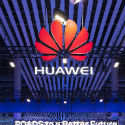
For a few days this week, Ericsson was able to boast a key technical advantage over Huawei, its longstanding nemesis. The Swedish vendor's new 5G radio unit, featuring 64 transmitters and receivers, weighed in at just 20 kilograms when it entered the boxing ring of the mobile infrastructure market. That was 45% less than its predecessor and 5 kilograms lighter than Huawei's equivalent, which had previously set the benchmark.
It has turned out to be a short-lived advantage. Just days later, at MWC Shanghai, Huawei showed off an even lighter unit. Like Ericsson's, it is an advanced "massive MIMO" unit with 64 transmitters and receivers. But at 19 kilograms, according to Huawei, it is precisely 1 kilogram less than the Swedish version. It is as if Huawei – knowing what Ericsson had planned – made an extra effort to spoil any Swedish celebrations and regain the title.
Figure 1:  Size matters, says Gan Bin, vice president of Huawei's wireless product line.
Size matters, says Gan Bin, vice president of Huawei's wireless product line.
Size and weight matter hugely in the radio game. Smaller units are easier to lug around and install in awkward places. A 16- or 17-kilogram weight reduction equals far less effort for technicians tasked with rollout. There is also a correlation between lightweight units and energy efficiency, partly because more cooling equipment is needed to prevent bulkier radios from overheating.
"There is a vicious cycle of cost that comes with less efficient radios," said Steve Papa, the CEO of US software company Parallel Wireless, during a previous conversation with Light Reading. "I might have to spend $25,000 to $50,000 reinforcing the steel on the tower to handle the weight. That dwarfs even the extra electricity costs. Now add in that I need bigger batteries, bigger generators, bigger diesel tanks and possibly more cooling of that equipment at the bottom of the tower."
Huawei's historical advantage in this area explains why operators have been drawn to its products, according to Papa. He credits the Chinese company's expertise in radio semiconductor design – through HiSilicon, its wholly owned chips business – and has repeatedly urged US authorities to pour Department of Defense funding into semiconductor alternatives.
Want to know more about 5G? Check out our dedicated 5G content channel here on
Light Reading.
It is hard, then, to see Ericsson's 45% weight reduction as anything other than a considerable achievement. Much like Papa, the Swedish company has alluded to the importance of semiconductor design in producing smaller and lighter radios. The application-specific integrated circuits developed by Ericsson Silicon, the equivalent of HiSilicon at Huawei, have underpinned the decrease in size and weight, says Sibel Tombaz, Ericsson's head of 5G high-band and mid-band active antenna systems.
Even if Ericsson reigned supreme for only a few days, a 1-kilogram difference barely matters next to the 11 or 12 kilograms that separated it from Huawei until this week. Its competitiveness further vindicates the decision by CEO Bórje Ekholm to sell non-core assets and pump additional funding into research and development (R&D). About 39.7 billion Swedish kronor ($4.8 billion) was spent on R&D last year, up from just SEK31.6 billion ($3.8 billion) across a more diverse range of activities in 2016, before Ekholm took over.
Yet Huawei's 19-kilogram response proves the beleaguered Chinese vendor remains at the cutting edge, despite the best efforts of US authorities to gum up its supply chains. Its new product is the "industry's lightest," it proclaimed in Shanghai, and one that can be transported and installed "by just one person." Where geopolitics and security concerns do not intrude, it remains a tough player to beat.
Related posts:
— Iain Morris, International Editor, Light Reading
About the Author(s)
You May Also Like




_International_Software_Products.jpeg?width=300&auto=webp&quality=80&disable=upscale)







